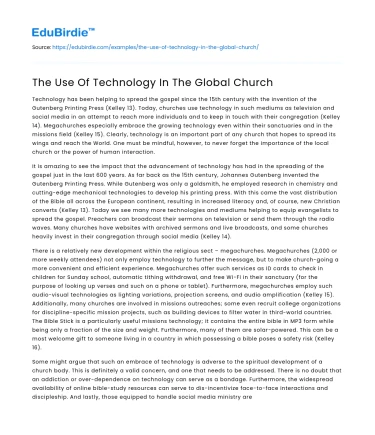Technology has been helping to spread the gospel since the 15th century with the invention of the Gutenberg Printing Press (Kelley 13). Today, churches use technology in such mediums as television and social media in an attempt to reach more individuals and to keep in touch with their congregation (Kelley 14). Megachurches especially embrace the growing technology even within their sanctuaries and in the missions field (Kelley 15). Clearly, technology is an important part of any church that hopes to spread its wings and reach the World. One must be mindful, however, to never forget the importance of the local church or the power of human interaction.
It is amazing to see the impact that the advancement of technology has had in the spreading of the gospel just in the last 600 years. As far back as the 15th century, Johannes Gutenberg invented the Gutenberg Printing Press. While Gutenberg was only a goldsmith, he employed research in chemistry and cutting-edge mechanical technologies to develop his printing press. With this came the vast distribution of the Bible all across the European continent, resulting in increased literacy and, of course, new Christian converts (Kelley 13). Today we see many more technologies and mediums helping to equip evangelists to spread the gospel. Preachers can broadcast their sermons on television or send them through the radio waves. Many churches have websites with archived sermons and live broadcasts, and some churches heavily invest in their congregation through social media (Kelley 14).
Save your time!
We can take care of your essay
- Proper editing and formatting
- Free revision, title page, and bibliography
- Flexible prices and money-back guarantee
There is a relatively new development within the religious sect – megachurches. Megachurches (2,000 or more weekly attendees) not only employ technology to further the message, but to make church-going a more convenient and efficient experience. Megachurches offer such services as ID cards to check in children for Sunday school, automatic tithing withdrawal, and free Wi-Fi in their sanctuary (for the purpose of looking up verses and such on a phone or tablet). Furthermore, megachurches employ such audio-visual technologies as lighting variations, projection screens, and audio amplification (Kelley 15). Additionally, many churches are involved in missions outreaches; some even recruit college organizations for discipline-specific mission projects, such as building devices to filter water in third-world countries. The Bible Stick is a particularly useful missions technology; it contains the entire bible in MP3 form while being only a fraction of the size and weight. Furthermore, many of them are solar-powered. This can be a most welcome gift to someone living in a country in which possessing a bible poses a safety risk (Kelley 16).
Some might argue that such an embrace of technology is adverse to the spiritual development of a church body. This is definitely a valid concern, and one that needs to be addressed. There is no doubt that an addiction or over-dependence on technology can serve as a bondage. Furthermore, the widespread availability of online bible-study resources can serve to dis-incentivize face-to-face interactions and discipleship. And lastly, those equipped to handle social media ministry are often less spiritually mature (Kelley 17). However, the church should not neglect the use of technology in an attempt to avoid these pitfalls – for that would be to neglect a whole missions field. Instead, it is the responsibility of church elders to oversee the use of technology and ensure that the focus of the church always remains on Jesus Christ and his finished work. Furthermore, despite the undeniable importance of missions work, it is still more important to ensure that the local body is being spiritually fed, lest they have nothing to share with the lost.
Despite the potential pitfalls of technology, it is vital to embrace it in order to spread the gospel to the world. Since the 15th century, mankind has seen the tremendous impact that technology has had in the service of sharing the gospel. The Gutenberg Printing Press was the first, but it has given way to so much more: radio, television, social media, etc (Kelley 14). Furthermore, megachurches employ technology to draw and accommodate a larger congregation, and many churches employ such technologies as the Bible Stick in their missions work (Kelley 16). Despite the downsides and concerns of technology, it is evident that the Christian effort would be stinted if the church was not to take full advantage of the technology at hand. It is important, therefore, that church leaders be vigilant in their efforts to monitor and regulate the use of technology lest they detract from the message of Jesus Christ.






 Stuck on your essay?
Stuck on your essay?

